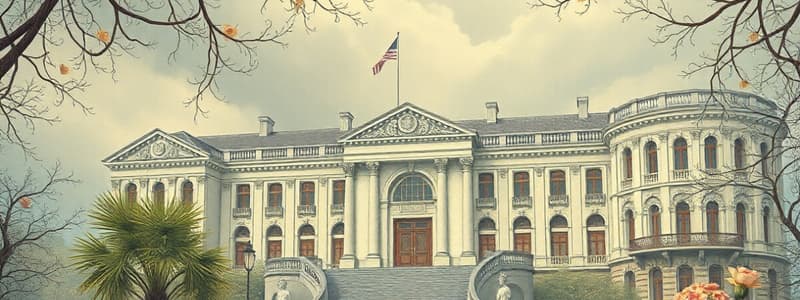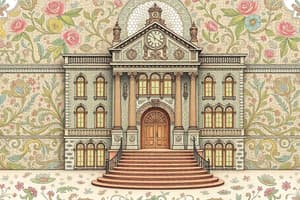Podcast
Questions and Answers
Which of the following is NOT one of the general types of agencies in the executive bureaucracy?
Which of the following is NOT one of the general types of agencies in the executive bureaucracy?
- Independent agencies
- Cabinet departments
- Government corporations
- Federal committees (correct)
It is uncommon for multiple agencies to be involved in a single issue within the executive bureaucracy.
It is uncommon for multiple agencies to be involved in a single issue within the executive bureaucracy.
False (B)
Executive branch departments are typically headed by Cabinet members called _______, except for the Department of Justice, which is headed by the attorney general.
Executive branch departments are typically headed by Cabinet members called _______, except for the Department of Justice, which is headed by the attorney general.
secretaries
To whom are Cabinet secretaries directly responsible?
To whom are Cabinet secretaries directly responsible?
Cabinet secretaries are only accountable to the president.
Cabinet secretaries are only accountable to the president.
Which of the following best describes the role of the Cabinet secretaries?
Which of the following best describes the role of the Cabinet secretaries?
Match the following government roles with their descriptions:
Match the following government roles with their descriptions:
Which scenario best exemplifies why Congress might create a government corporation?
Which scenario best exemplifies why Congress might create a government corporation?
Government corporations, like the Postal Service, are funded exclusively through taxpayer dollars.
Government corporations, like the Postal Service, are funded exclusively through taxpayer dollars.
Match the following government corporations with the primary reason for their creation:
Match the following government corporations with the primary reason for their creation:
Which of the following organizational structures is responsible for easing the administrative tasks of the secretary?
Which of the following organizational structures is responsible for easing the administrative tasks of the secretary?
Departments organized to promote the interests of a specific group are called ______ agencies.
Departments organized to promote the interests of a specific group are called ______ agencies.
Why did Congress establish government corporations?
Why did Congress establish government corporations?
All government agencies operate in the same way and serve the same functions.
All government agencies operate in the same way and serve the same functions.
Government agencies play no role in the economy.
Government agencies play no role in the economy.
Flashcards
Cabinet Departments
Cabinet Departments
Major administrative units of the U.S. government, each responsible for specific areas.
Assistant Secretaries
Assistant Secretaries
Officials who manage major programs within a cabinet department.
Clientele Agencies
Clientele Agencies
Departments organized to promote the interests of specific social or economic groups.
Bureaus or Divisions
Bureaus or Divisions
Signup and view all the flashcards
Government Corporations
Government Corporations
Signup and view all the flashcards
U.S. Postal Service
U.S. Postal Service
Signup and view all the flashcards
Administrative Burden
Administrative Burden
Signup and view all the flashcards
Functional Lines
Functional Lines
Signup and view all the flashcards
Tennessee Valley Authority (TVA)
Tennessee Valley Authority (TVA)
Signup and view all the flashcards
Amtrak
Amtrak
Signup and view all the flashcards
Government Intervention
Government Intervention
Signup and view all the flashcards
Public Utilities
Public Utilities
Signup and view all the flashcards
Private Corporation Comparison
Private Corporation Comparison
Signup and view all the flashcards
Types of Agencies
Types of Agencies
Signup and view all the flashcards
Executive Bureaucracy
Executive Bureaucracy
Signup and view all the flashcards
Cabinet Secretary
Cabinet Secretary
Signup and view all the flashcards
Cabinet Workforce
Cabinet Workforce
Signup and view all the flashcards
Dual Accountability
Dual Accountability
Signup and view all the flashcards
Department Structure
Department Structure
Signup and view all the flashcards
Permanent National Interest
Permanent National Interest
Signup and view all the flashcards
Study Notes
General Types of Agencies
- There are an estimated 1,149 civilian agencies, including government agencies, commissions, and departments.
- A key characteristic of the executive bureaucracy is its division into specialized areas.
- Agencies may overlap in their jurisdictions, dealing with numerous issues simultaneously.
Cabinet Departments
-
There are fifteen Cabinet departments, which are major administrative units.
-
They have responsibility for specific broad areas of government operations.
-
Departmental status often signifies a permanent national interest in a particular governmental function (e.g., defense, commerce, agriculture).
-
They employ about 60% of the federal workforce.
-
Secretaries are responsible for the departments' general policy and operations.
-
Secretaries report to the president, but also interact with Congress regarding budget and policy implementation.
-
Secretaries are assisted by deputies, undersecretaries, assistant secretaries, and numerous other assistants.
-
Cabinet departments have sub-units like bureaus, divisions, and sections, where most work is carried out.
-
Some departments focus on particular social or economic groups, known as clientele agencies.
-
Examples of clientele agencies include Agriculture, Education, Energy, Labor, Veterans Affairs, and the Bureau of Indian Affairs.
Government Corporations
- Government corporations are businesses established by Congress to perform functions that could be handled by private businesses (e.g., U.S. Postal Service).
- They are more flexible than regular departments.
- They are formed when activities are primarily commercial and require flexibility exceeding what Congress normally allows regular departments.
- Government corporations, like the U.S. Postal Service (UPS), often provide services at cheaper rates than private businesses.
- Congress may establish a government corporation to handle public assets, like passenger rail service (Amtrak).
Studying That Suits You
Use AI to generate personalized quizzes and flashcards to suit your learning preferences.



